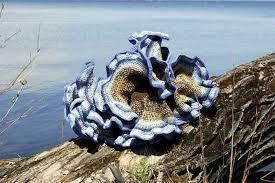For lack of a better term, I'm a closet mathematician. I love math, but do tend to hide it pretty well. Until, that is, I find some books that correlate math with fiber arts. Now I absolutely have to come out of the closet!!
First I found
Crocheting Adventures with Hyperbolic Planes by Daina Taimina, which is absolutely fascinating in explaining a complex geometric concept in very understandable terms. Basically a hyperbolic plane is a surface in 3-space with constant negative curvature. (And that's the simple explanation. It certainly gets more complicated from there. Just check out http://en.wikipedia.org/wiki/Hyperbolic_geometry if you need to know the details.) That's why this book is so captivating. And her fiber creations are beautiful. And yes, she includes the pattern and how to calculate how to create your own crocheted versions.

 Daina Taimina... sparked great interest in this new tactile way of exploring concepts of hyperbolic geometry, making this advanced topic accessible to wide audiences http://en.wikipedia.org/wiki/Daina_Taimina
Daina Taimina... sparked great interest in this new tactile way of exploring concepts of hyperbolic geometry, making this advanced topic accessible to wide audiences http://en.wikipedia.org/wiki/Daina_Taimina
Naturally this led me to another discovery: Making Mathematics with Needlework, edited by Sarah-Marie Belcastro and Carolyn Yackel. From her website: So, what is in the book? Every chapter (except for the introduction) has four sections. First, there's an overview intended for both crafters and mathematicians, so it should be understandable to mathematicians who don't know anything about crafting and also for crafters who don't know anything about mathematics. Then, there's a section of detailed mathematics that is intended for mathematicians. All of the authors have made an effort to include basic information so that mathematical enthusiasts who are not professional mathematicians can follow the bulk of the material. The third section of each chapter contains teaching ideas, and these range from elementary-school level to graduate level. Finally, every chapter has a project, with instructions written for and tested by crafters.
There is an index with both mathematics and craft terms, and the usual acknowledgements, credits, table of contents, and such. http://www.toroidalsnark.net/mkbook.html

Just being able to read the mathematical equations associated with mobius bands, picking up stitches in knitting, crochet designs, the algebraic structure in socks, cables & braids, and so much more, makes me ever so happy.
She also talks about toroidal snarks on her website, but that is another topic for another day.
And now my secret is out.







